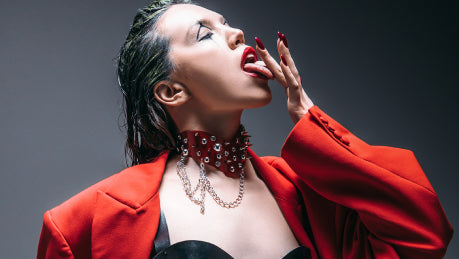From Victorian Corsets to Post-Fetish Aesthetics: The Evolution of Gothic Style
The history of gothic fashion is a study of transformation, a narrative where rebellion meets elegance, and darkness merges with romanticism. What began as a reflection of 19th-century mourning dress evolved into one of the most distinctive and enduring movements in global fashion.
Today, you can trace the journey of goth identity through centuries of clothes, music, and cultural expression, from the Victorian corset and velvet dress to the leather harness and choker of contemporary streetwear.
This movement, always steeped in beauty and shadow, represents a continuous dialogue between the past and the future, between control and creative freedom.

Victorian Roots: Elegance and Darkness Combined
The Victorian era set the foundation for gothic aesthetics. In the 19th century, fashion was a form of social and emotional language - mourning attire, intricate corsets, and high collars symbolized both modesty and sorrow. Women wore black velvet, silk, and lace as a form of romantic defiance, creating silhouettes that still inspire designers today.
The style was as much about restraint as it was about expression. A belt cinched tightly around the waist or a lace-up corset emphasized structure and discipline. Yet beneath that rigidity existed something more - the beginning of goth fashion, where elegance became intertwined with emotional intensity. The influence of Victorian architecture, literature, and mourning rituals shaped what would later become an entire subculture rooted in dark beauty and introspection.
Gothic Revival in the 1970s–1980s: Subculture and Music

Fast-forward to the 1970s and 1980s, when punk rebellion paved the way for a new aesthetic. This was the era of Siouxsie and the Banshees, of Vampira’s cinematic legacy, and of music that fused anarchy with art. The goth subculture emerged as an emotional, visual, and auditory response to social alienation. Gothic fashion evolved from punk roots but added layers of romantic refinement.
Black lace, leather, and metal chains replaced the bright tones of hippie clothing, and the look became defined by eyeliner, lipstick, and androgynous makeup. The outfit of a goth was not simply clothing, but a statement, a rejection of the mainstream and an embrace of individuality. A leather jacket paired with a gothic harness or belt became a new form of armor, fusing rebellion with sensual restraint. The movement thrived in nightclubs, music venues, and underground art scenes, building a community bound by creativity and shared identity.
Fetish and Industrial Influence: The 1990s Transformation

By the 1990s, goth fashion had absorbed fetish, industrial, and cyber elements. Materials like latex, PVC, and heavy leather became standard. The goth body harness or goth chest harness, once reserved for subcultural nightlife - entered runway collections and street style editorials.
This decade blurred the line between subculture and mainstream. Designers such as Rick Owens incorporated gothic undertones into modern fashion, creating looks that balanced structure and sensuality. The gothic leather harness became both accessory and statement, symbolizing empowerment through controlled aesthetic rebellion.
In clubs filled with strobes and neon, the dark silhouettes glimmered with metal accents, drawing attention to the body as both armor and art. The harness, belt, and jacket evolved beyond fetish origins into objects of design philosophy - embodiments of freedom within structure.
Post-Fetish and Contemporary Goth: Modern Interpretations
Today, goth style is more inclusive, embracing gender fluidity, plus size goth harness designs, and plus size harness gothic silhouettes that celebrate every body type. The gothic harness belt or leather choker has transitioned from subversive symbol to high-end accessory - a centerpiece of modern collections by both luxury and independent brands.
For example, in the online store Bleak&Sleek you can order an interesting accessory - Althea Harness. The highlight of this harness is the thin straps that wrap around the body and neck, creating an unforgettable look. This Harness looks best with clothes that have an open collar - blouses, shirts, tops with thin straps. It has decorations in the form of metal rings that add gothicness to the image.
Among the extremely original accessories that recall the spirit of the Victorian era is the leather Wasp Corset Belt. Its thoughtful design allows you to wear the buckles both in front and in the back, forming an expressive accent in any image. The Wasp design gently emphasizes the contours of the body, creating the effect of an “hourglass” waist and giving the silhouette elegance and sensual charm.
Symbolism and Cultural Impact
Beyond the fashion, the goth movement speaks to deeper symbolism, introspection, art. The look continues to influence movies, music, and even architecture. The interplay between light and darkness, structure and emotion, keeps this aesthetic both mysterious and relevant.
The gothic harness, for instance, embodies this tension perfectly - structured, restrictive, yet deeply sensual. A good option for creating a modern look is the Fall in Love Harness. The accessory is worn under the chest, has many thin straps with metal buckles. The accessory looks elegant, at the same time militant, and creates an extraordinary image.
Some symbols of gothic fashion never fade: the corset, the leather harness, the black dress, and the aura of mystery. The style evolves with each decade, yet its essence endures a devotion to dark beauty, a rejection of conformity, and an embrace of self-expression.
Whether you’re drawn to soft romantic silhouettes or futuristic industrial lines, gothic aesthetics offer endless possibilities for self-expression: a harness or minimalist belt can redefine proportions and add strength to the look, while a choker or necklace can completely transform your style.

Galla Koltunova
Сo-founder of Bleak & Sleek, specializes in leathercraft and transforms traditional techniques into contemporary accessories. In her creations, leather becomes more than just a material - it turns into a language of self-expression and strength.








